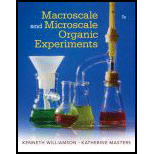
Macroscale and Microscale Organic Experiments
7th Edition
ISBN: 9781305577190
Author: Kenneth L. Williamson, Katherine M. Masters
Publisher: Brooks Cole
expand_more
expand_more
format_list_bulleted
Question
Chapter 3, Problem 4Q
Interpretation Introduction
Interpretation:
The observed and the true melting point due to the rapid heating of the melting point bath should be compared.
Concept introduction:
Temperature at which an element changes from the solid state to the liquid state is known as melting point or sometimes liquefaction point. At the melting point, both solid and liquid phase coexist in equilibrium. It depends on the pressure and is normally defined at the standard pressure
Expert Solution & Answer
Want to see the full answer?
Check out a sample textbook solution
Students have asked these similar questions
Filter paper is usually a poor material on which to powder a solid sample before
introducing it into a capillary melting-point tube because small particles of
paper may end up in the tube along with the sample. Why is this undesirable?
and how might the presence of paper in the sample make the melting-point
determination difficult
How does the rate of temperature elevation influence the results of the melting point determination?
In order to obtain accurate data it is important to add hear slowly and steadily when the temperature gets close to the melting point of a sample. Why is necessary?
Chapter 3 Solutions
Macroscale and Microscale Organic Experiments
Knowledge Booster
Similar questions
- Briefly describe the technique for packing a capillary melting point-tubearrow_forwardTrue or False. It is very important to regulate the temperature of the heating mantle so that the distillation occurs at a rate of about 1 drop per 2 seconds. Explain why?arrow_forwardA student placed about 1 cm of freshly recrystallized loosely packed solid into a melting-point capillary tube. The student noted that the solid melted 30 degrees lower than expected and the solid seemed to jump/separate in the tube as the temperature increased in the melting point apparatus. When the student measured the melting point the following day with less solid that was more tightly packed, the melting point was at the literature value. Explain what all went wrong with the student's first samplearrow_forward
- How does the melt temperature of the main phase affect diffusion?arrow_forward. When checking the melting point of your impure sample, what temperature should you set as thestarting temperature (the SET temperature) and what should the ramp rate be?arrow_forwardMay you Graph of temperature versus fraction number for the distilled liquid and show the extrapolation of the liquid’s boiling point. Fraction # Average Temperature 1 51 2 51.6 3 51.8 4 52 5 52 6 52 7 52 8 52arrow_forward
- What is done if the solid contains a colored impurity? Know the proper funnels and equipment to use. What is done if a solid impurity remains after your desired compound is dissolved in asolvent? When do you read the temperature to determine the boiling point of a liquid whendoing microscale boiling point determinationarrow_forwardObservation on determination of melting point of Solvent How can I identify the freezing point of this solvent? is it 51.0 where it is still in solid form? Temperature State on the capilary tube 51.0 solid 52.0 solid 53.0 liquid-solid 54.0 liquid-solid 55.0 liquid-solid 57.0 liquidarrow_forwardIn which of the following scenarios might you expect the observed melting point to be depressed? Choose all that apply. a. The heating rate for measuring the melting point was set too high. b. The percent recovery of recrystallized solid was less than 100%. c. A solid that was recrystallized from hexane was filtered and dried without washing with additional hexane while it was on the filter funnel. d. A solid recrystallized from toluene was left on the filter funnel for only a short time before its melting point was measured. e. The melting point capillary tube was packed with too much material.arrow_forward
- What effect will the following have on plate height (H). Make sure to explain your full and complete reasoning. a. Increasing stationary phase thicknessarrow_forward1. If all the ice were to melt just as the temperature reached 3.0 °C, would thisproduce an error in your experimental values? Explain your reasoning.arrow_forwardIn the event that you were given a known chemical for the purpose of determining the melting point, how would you be able to prove that it was not another compound with the same melting point?arrow_forward
arrow_back_ios
SEE MORE QUESTIONS
arrow_forward_ios
Recommended textbooks for you
 Macroscale and Microscale Organic ExperimentsChemistryISBN:9781305577190Author:Kenneth L. Williamson, Katherine M. MastersPublisher:Brooks Cole
Macroscale and Microscale Organic ExperimentsChemistryISBN:9781305577190Author:Kenneth L. Williamson, Katherine M. MastersPublisher:Brooks Cole

Macroscale and Microscale Organic Experiments
Chemistry
ISBN:9781305577190
Author:Kenneth L. Williamson, Katherine M. Masters
Publisher:Brooks Cole